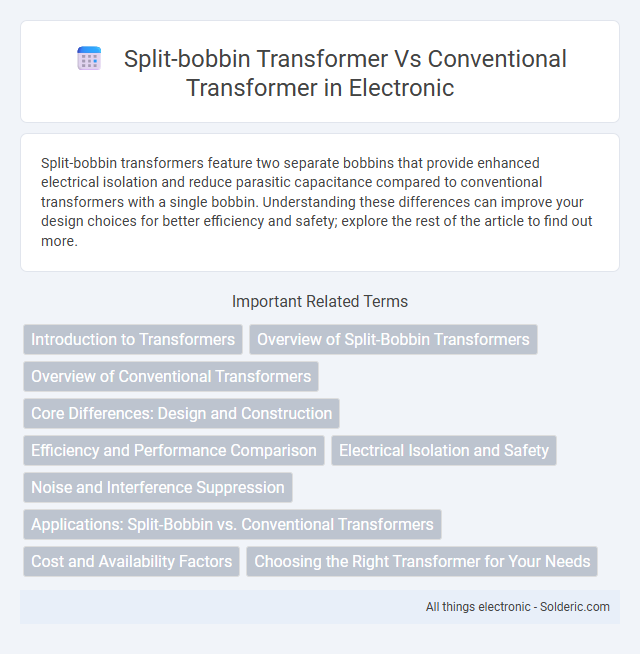Split-bobbin transformers feature two separate bobbins that provide enhanced electrical isolation and reduce parasitic capacitance compared to conventional transformers with a single bobbin. Understanding these differences can improve your design choices for better efficiency and safety; explore the rest of the article to find out more.
Comparison Table
| Feature | Split-Bobbin Transformer | Conventional Transformer |
|---|---|---|
| Windings Structure | Separate bobbins for primary and secondary windings | Single bobbin with layered windings |
| Electromagnetic Isolation | Better isolation due to physical separation | Less isolation, windings closely packed |
| Manufacturing Complexity | Moderate, requires precise assembly of two bobbins | Simpler, single winding process |
| Heat Dissipation | Improved heat dissipation through separated windings | Heat accumulates due to layered windings |
| Size and Weight | Typically larger and slightly heavier | More compact and lighter |
| Cost | Higher cost due to complexity and materials | Lower cost, simpler design |
| Application | High-voltage, high-isolation requirements | General-purpose, low to medium voltage |
Introduction to Transformers
Split-bobbin transformers feature two separate bobbins for primary and secondary windings, enhancing electrical isolation and reducing leakage inductance compared to conventional transformers with a single bobbin. This design improves thermal management and minimizes electromagnetic interference, making split-bobbin transformers ideal for sensitive electronic circuits. Conventional transformers typically have simpler construction but may exhibit higher parasitic capacitance and noise susceptibility.
Overview of Split-Bobbin Transformers
Split-bobbin transformers feature separate plastic bobbins for primary and secondary windings, providing improved electrical isolation and enhanced safety compared to conventional transformers where windings share a single bobbin. Their design reduces leakage inductance and minimizes the risk of short circuits, making them ideal for applications requiring strict safety standards, such as medical and industrial equipment. Your choice of a split-bobbin transformer ensures better insulation integrity and compliance with regulatory insulation requirements.
Overview of Conventional Transformers
Conventional transformers consist of a single bobbin around which the primary and secondary windings are coiled, providing a straightforward design primarily used for voltage conversion and isolation in power systems. These transformers typically feature laminated iron cores to reduce eddy current losses and improve efficiency during energy transfer. Commonly employed in power distribution, their limitations include larger size and higher parasitic capacitances compared to specialized transformers like split-bobbin designs.
Core Differences: Design and Construction
Split-bobbin transformers feature two separate bobbins for primary and secondary windings, reducing capacitive coupling and enhancing electrical isolation compared to conventional transformers with a single bobbin. Their design allows for improved safety and EMI performance, making them suitable for sensitive electronic applications. Understanding these core differences helps you choose the right transformer for optimal efficiency and reliability.
Efficiency and Performance Comparison
Split-bobbin transformers typically offer improved efficiency by minimizing leakage inductance and electromagnetic interference compared to conventional transformers, resulting in better performance in sensitive electronic applications. Their design allows for more effective heat dissipation, which enhances reliability and operational lifespan under higher loads. You can expect split-bobbin transformers to deliver superior energy savings and reduced operational noise, making them ideal for high-performance power supply systems.
Electrical Isolation and Safety
Split-bobbin transformers offer enhanced electrical isolation by physically separating the primary and secondary windings, significantly reducing the risk of short circuits and electrical faults. Conventional transformers typically use a single bobbin, which can allow closer winding proximity and increase potential leakage currents, impacting overall safety. Your choice of a split-bobbin design ensures better insulation and compliance with stricter safety standards in sensitive applications.
Noise and Interference Suppression
Split-bobbin transformers offer superior noise and interference suppression compared to conventional transformers by physically separating the primary and secondary windings, reducing capacitive coupling and electromagnetic interference. This design minimizes audible hum and electromagnetic noise, making split-bobbin transformers ideal for sensitive audio and communication applications where signal integrity is crucial. Conventional transformers, with windings closer together, tend to allow more crosstalk and noise leakage, affecting performance in high-sensitivity environments.
Applications: Split-Bobbin vs. Conventional Transformers
Split-bobbin transformers excel in applications requiring enhanced insulation and reduced interwinding capacitance, making them ideal for high-frequency circuits, medical devices, and safety-critical environments. Conventional transformers are commonly used in power distribution, industrial equipment, and general-purpose applications due to their simpler design and cost-effectiveness. Your choice depends on the need for electrical isolation and noise reduction versus efficiency and budget considerations.
Cost and Availability Factors
Split-bobbin transformers often offer cost advantages due to simplified manufacturing processes and reduced material usage compared to conventional transformers, leading to lower production expenses. Their common use in low-power applications ensures readily available components and widespread supply chains, enhancing availability. Conversely, conventional transformers, with more robust construction for higher power ratings, may incur higher costs and longer lead times due to more complex designs and specialized materials.
Choosing the Right Transformer for Your Needs
Split-bobbin transformers offer enhanced electrical isolation and reduced parasitic capacitance compared to conventional transformers, making them ideal for sensitive electronic applications requiring minimal interference. Conventional transformers typically provide higher power ratings and cost-effectiveness, suited for general power distribution and industrial use. Selecting the right transformer depends on application-specific requirements such as safety standards, noise immunity, power capacity, and thermal performance.
split-bobbin transformer vs conventional transformer Infographic

 solderic.com
solderic.com